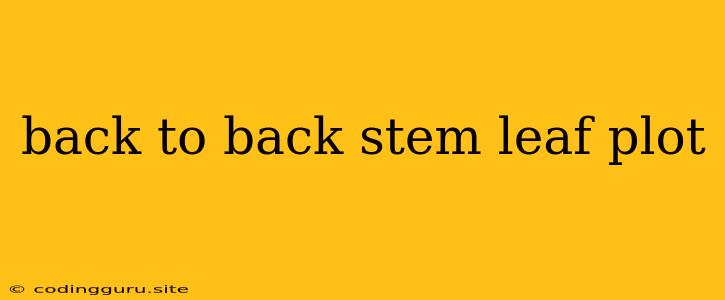Understanding Back-to-Back Stem-and-Leaf Plots
A stem-and-leaf plot is a valuable tool in statistics for visualizing data, particularly when working with small datasets. It helps us understand the distribution of data and identify patterns, outliers, and the center of the data. But sometimes, we need to compare two datasets simultaneously to see how they relate to each other. This is where the back-to-back stem-and-leaf plot comes in.
What is a Back-to-Back Stem-and-Leaf Plot?
A back-to-back stem-and-leaf plot is a visual representation that allows us to compare two datasets side-by-side using the same stem values. The stem is shared in the middle, and the leaves for each dataset are arranged in opposite directions, forming a back-to-back arrangement. This visual comparison makes it easy to see differences and similarities between the two datasets.
Why Use a Back-to-Back Stem-and-Leaf Plot?
-
Direct Comparison: Back-to-back stem-and-leaf plots facilitate a direct comparison of two datasets, allowing us to analyze the differences in their distribution, central tendency, and spread.
-
Visual Representation: The plot offers a clear visual representation of the data, making it easier to interpret and draw conclusions than by simply looking at raw numbers.
-
Preservation of Data: Unlike other graphical representations like histograms, the stem-and-leaf plot preserves the actual data values, allowing us to see the exact individual values within each dataset.
Creating a Back-to-Back Stem-and-Leaf Plot
-
Identify the Stem: Choose the appropriate stem values that will encompass the range of data in both datasets.
-
Arrange the Leaves: Place the leaves for each dataset on opposite sides of the shared stem. For example, if you have data values of 12, 14, and 18 in one dataset, and 15, 16, and 19 in the other dataset, your stem would be "1" and the leaves would be:
1 | 2 4 8 | 5 6 9 -
Order the Leaves: Ensure that the leaves are arranged in ascending order within each set of leaves.
-
Label the Plot: Label each side of the plot with the name or description of the corresponding dataset.
Example: Comparing Test Scores
Let's say we want to compare the test scores of two different classes. Here's how a back-to-back stem-and-leaf plot would help:
Class A Scores: 72, 75, 81, 83, 85, 88, 90, 92, 95, 98
Class B Scores: 78, 80, 82, 84, 86, 87, 89, 91, 93, 97
9 | 8 7 5 3 2 | 7 3 1
8 | 8 5 3 1 | 9 7 6 4 2 0
7 | 5 2 | 8
```
**Interpreting the Plot:**
* **Distribution:** Both classes seem to have scores distributed around the same range, but Class A has a few higher scores, as indicated by the extended leaf values on the left side.
* **Central Tendency:** Class B might have a slightly higher average score, as the majority of its data points are clustered towards the higher end.
* **Spread:** Class B appears to have a smaller spread of scores compared to Class A, with its leaves clustered more closely together.
**Advantages of Back-to-Back Stem-and-Leaf Plots**
* **Visual Comparison:** Offers a visual comparison of two datasets, facilitating easier analysis.
* **Preservation of Data:** Retains the actual data values, enabling detailed observation.
* **Compact Representation:** Provides a concise and efficient way to represent two sets of data simultaneously.
* **Suitable for Small Datasets:** Particularly useful for smaller datasets, allowing for easy interpretation and comparison.
**Limitations of Back-to-Back Stem-and-Leaf Plots**
* **Limited to Small Datasets:** Less effective for larger datasets, as the plot can become crowded and difficult to read.
* **Inefficient for Categorical Data:** Not appropriate for analyzing data that is categorical or involves multiple variables.
**Conclusion**
Back-to-back stem-and-leaf plots offer a simple and effective way to visually compare two datasets. They are particularly helpful when working with small datasets and allow us to understand the differences in their distribution, central tendency, and spread. While they have limitations, they can provide valuable insights for making informed decisions based on the data.
